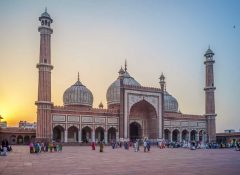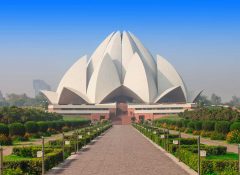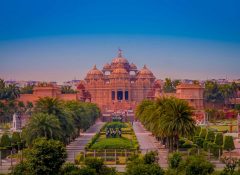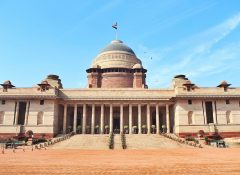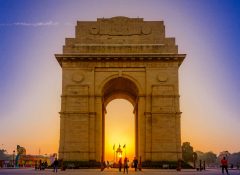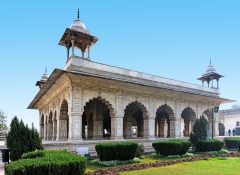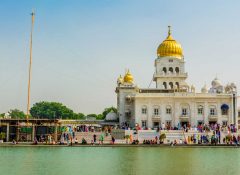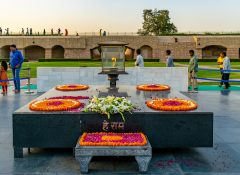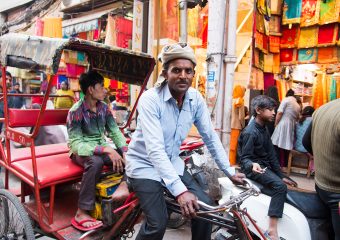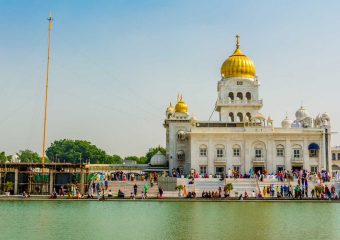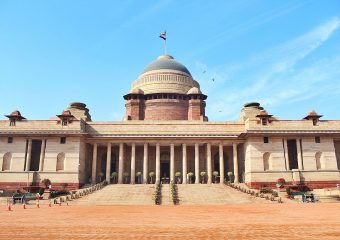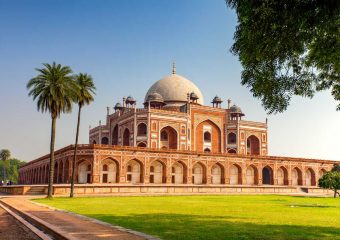Delhi is the Capital city of India and is an amalgamation of old and new. A metropolitan city of today has always been inhabited since 6th century BC. Through most of its history, Delhi has served as a capital of various kingdoms and empires. It has been captured, ransacked and rebuilt several times, particularly during the medieval period. Modern Delhi is a cluster of a number of cities spread across the metropolitan region. Today’s Delhi is dotted with ancient monuments and architecturally well planned city of Sir Edward Lutyen during the British Raj. The narrow, winding lanes and by lanes of old Delhi are a testament to the former Mughal rule. New Delhi is well planned city during the colonial rule with its tree-lined avenues, imposing structures and buildings such as the Rashtrapati Bhavan, Parliament House and India Gate, reflect Delhi’s colonial past.
Humayun’s Tomb is the tomb of second Mughal Emperor Humayun and was constructed in 1569-70. The mausoleum is the finest example of Mughal architecture. It represented a leap in Mughal architecture, and together with its accomplished Charbagh garden, typical of Persian gardens, but never seen before in India, it set a precedent for subsequent Mughal architecture. After a century from its construction Humayun’s tomb inspired the construction of the more famous Taj Mahal. Humayun’s Tomb is a UNESCO World Heritage site.
Chandni Chowk or the Moonlight Square is one of the most busiest markets of old Delhi. The market has been in existence for three centuries and markets full of spices, dried fruits, silver jewelry and merry saris, while the narrow side streets are lined with small shops selling essential oils, stationery and Traditional sweets from India. A rickshaw ride through the fumes and fragrances in the narrow lanes and by-lanes of this market is often enjoyed by visitors.
Lotus Temple or Bahai Temple was built in 1987. Notable for its distinctive Lotus flower shaped design, temple is open to all, regardless of cast , creed or religion. Its nine access doors to the central hall of temple symbolize the diversity of races and their essential unity. The Lotus Temple has won numerous architectural awards and has been featured in many newspaper and magazine articles.
Qutub Minar is a 73 meters tall minaret in Qutub Complex , a UNESCO World Heritage Site. The Qutab Minar is the tallest brick minaret in the world and a leading example of Islamic art. The soaring Tower of Victory was built in 1193 by Qutub-ud-din-Aibak has five distinct storeys. At the foot of the tower is the Quwwat-ul-Islam Mosque, the first mosque to be built in India.
Akshardham Temple in Delhi belongs to Swami Narayan sect is one of the largest Hindu temples in the world. The temple is the unique example of 10,000 years of Indian culture in all its breathtaking grandeur, beauty, wisdom and bliss. The temple showcases the essence of India’s ancient architecture, traditions and timeless spiritual messages. This Stunning architectural work made of the pink stone and white Marble is constructed recently. It’s monumental and eclectic beauty has made it one of the most popular Hindu Temples.
President House and Parliamentary Buildings are the part of Luyten’s Delhi and were constructed between 1920 and 1940 soon after it was decided that the capital of British India shall be shifted from Calcutta to Delhi. President House or The Rashtrapati Bhawan is the home to the President of the largest democracy in the world. Other notable buildings designed by Sir Edward Luyten and his team are Parliament House , North and South Blocks which house the offices of ministers and other government officials.
India Gate was constructed in 1931 is a war memorial to the 70,000 British Indian Army who died during the First World War. The 42 m high India Gate, an “Arc-de-Triomphe” like archway in the middle of a crossroad, the memorial bears the names of more than 13,516 British and Indian soldiers killed in the Northwestern Frontier in the Afghan war of 1919.
Red Fort in Delhi was constructed in 1639 by fifth Mughal Emperor Shah Jahan is the historic fort and a UNESCO World Heritage Site. The fort houses many palaces in its complex namely Diwan-e-am , Diwan-E-Khas , Drum House , Pearl Mosque. The main gate, Lahore Gate, is one of the emotional and symbolic focal points of the modern Indian nation and attracts a major crowd on each Independence Day on 15th August.
Gurudwara Bangla Sahib or just Sikh Temple in Delhi the one of the main worship place for Sikhs. A beautiful white building flanked with a golden dome has a pool (sarovar) inside the complex where devotee takes bath before entering the temple. The holy rhymes of Gurubani meditate the visitor. A large kitchen in-side the temple serve free food daily to all the visitors of all religions , society , cast and creed.
Artisans and Markets of Delhi : Delhi is the paradise for shoppers. One can buy any and all the things here. Right from the world famous brands to hand crafted artisans products can be explored here in Delhi. Dilli Haat is one of the important shopping complex provides the ambiance of a traditional Rural Haat or village market. Artisans and craftsmen from all over the country gather here to showcase and sell their handicraft. Cannaught Palace right in the heart of Delhi is the best place to take the pulse to the new part of the city. A huge circular plaza serves as a crossroads to some of the main avenues. Go shopping, dine in a beautiful restaurant, visit a market or simply sit on a bench.
Special Experience
 Bird Hospital in Chandni Chowk treats up to 60 birds a day for free. People bring injured and sick birds which are set free post treatment, after the creature regained the health.
Bird Hospital in Chandni Chowk treats up to 60 birds a day for free. People bring injured and sick birds which are set free post treatment, after the creature regained the health.
Unforgettable Experience

A relaxing Ayurveda massage after a long journey is always rejuvenating. Experience special ayurvedic inspired massage Abhaynga in which warm fusion of individually selected essential oils and specialised techniques to achieve a total sense of relax and well being.


